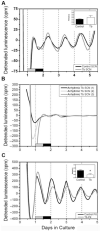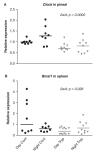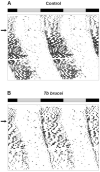Clock gene expression during chronic inflammation induced by infection with Trypanosoma brucei brucei in rats
- PMID: 20348460
- PMCID: PMC2897063
- DOI: 10.1177/0748730409360963
Clock gene expression during chronic inflammation induced by infection with Trypanosoma brucei brucei in rats
Abstract
African sleeping sickness is characterized by alterations in rhythmic functions. It is not known if the disease affects the expression of clock genes, which are the molecular basis for rhythm generation. We used a chronic rat model of experimental sleeping sickness, caused by the extracellular parasite Trypanosoma brucei brucei (Tb brucei), to study the effects on clock gene expression. In tissue explants of pituitary glands from Period1-luciferase (Per1-luc) transgenic rats infected with Tb brucei, the period of Per1-luc expression was significantly shorter. In explants containing the suprachiasmatic nuclei (SCN), the Per1-luc rhythms were flat in 21% of the tissues. We also examined the relative expression of Per1, Clock, and Bmal1 mRNA in the SCN, pineal gland, and spleen from control and infected rats using qPCR. Both Clock and Bmal1 mRNA expression was reduced in the pineal gland and spleen following Tb brucei infection. Infected rats were periodic both in core body temperature and in locomotor activity; however, early after infection, we observed a significant decline in the amplitude of the locomotor activity rhythm. In addition, both activity and body temperature rhythms exhibited decreased regularity and "robustness." In conclusion, although experimental trypanosome infection has previously been shown to cause functional disturbances in SCN neurons, only 21% of the SCN explants had disturbed Per1-luc rhythms. However, our data show that the infection overall alters molecular clock function in peripheral clocks including the pituitary gland, pineal gland, and spleen.
Figures





References
-
- Brandenberger G, Buguet A, Spiegel K, Stanghellini A, Muanga G, Bogui P, Dumas M. Disruption of endocrine rhythms in sleeping sickness with preserved relationship between hormonal pulsatility and the REM-NREM sleep cycles. J Biol Rhythms. 1996;11:258–267. - PubMed
-
- Buguet A, Bert J, Tapie P, Tabaraud F, Doua F, Lonsdorfer J, Bogui P, Dumas M. Sleep-wake cycle in human African trypanosomiasis. J Clin Neurophysiol. 1993;10:190–196. - PubMed
-
- Buguet A, Gati R, Sevre JP, Develoux M, Bogui P, Lonsdorfer J. 24 hour polysomnographic evaluation in a patient with sleeping sickness. Electroencephalogr Clin Neurophysiol. 1989;72:471–478. - PubMed
-
- Buijs RM, Scheer FA, Kreier F, Yi C, Bos N, Goncharuk VD, Kalsbeek A. Organization of circadian functions: interaction with the body. Prog Brain Res. 2006;153:341–360. - PubMed
-
- Chevrier C, Canini F, Darsaud A, Cespuglio R, Buguet A, Bourdon L. Clinical assessment of the entry into neurological state in rat experimental African trypanosomiasis. Acta Trop. 2005;95:33–39. - PubMed
Publication types
MeSH terms
Substances
Grants and funding
LinkOut - more resources
Full Text Sources

